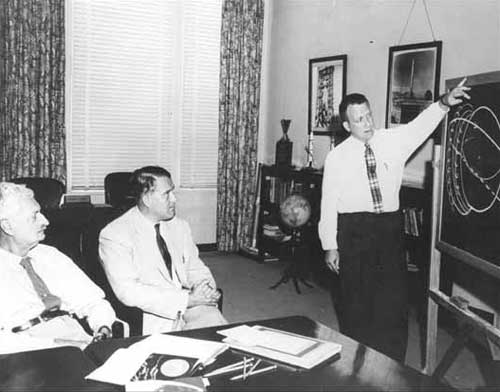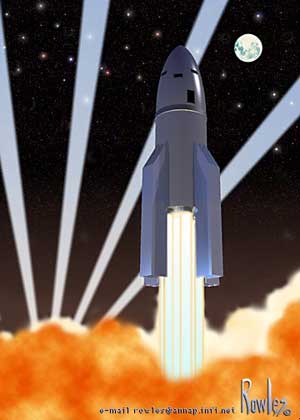The space exploration endeavor is fundamentally based on the theories of four scientists who, while contemporaneous, did not collaborate with each other. They researched concurrently and complemented the foundations of rocket technology. These four pioneers are Konstantin Tsiolkovsky from Russia, Robert Goddard from the United States, Hermann Oberth from Germany, and Theodore von Kármán from Austria-Hungary.

Hermann Oberth (1894-1989), left, with Russian Konstantin Tsiolkovsky and American Robert Goddard
discussing elliptical orbits in this undated image (Photo: NASA)
Hermann Julius Oberth was born on June 25, 1894, in Hermannstadt, located in Transylvania. This region initially belonged to the Austro-Hungarian Empire but became part of Romania after World War I and is now part of eastern Germany. On the map, Hermannstadt is referred to as Sibiu, an Austro-Hungarian name, although the inhabitants of this area are of German descent, speak German, and follow the customs of the Saxon community.
Hermann J. Oberth was the son of Dr. Julius Gotthold Oberth, the director of a hospital near Schassburg. From a young age, Hermann dreamed of becoming a brilliant engineer or scientist and worked hard to realize this dream.
While attending Bischof-Teutsch High School in Schassburg, Hermann had the opportunity to read the works of authors Jules Verne and H. G. Wells. The scientific predictions in these stories fascinated him, leading to his disillusionment with the field of medicine, which was the path his father had set for him.
In 1912, Hermann graduated from high school and received a mathematics award for his excellent work. Despite his talent in mathematics, Hermann followed his father’s wishes and enrolled in medical school at the University of Munich. However, during this time, he found subjects like astronomy, physics, and mathematics far more interesting than the courses on anatomy.
When Hermann Oberth turned 20, World War I broke out. He was drafted into the Austro-Hungarian army, suffered a minor injury, and was transferred to a medical unit. During this time, Oberth wrote many theories on space travel, realizing that he would never become a doctor.
After the war, Oberth returned to university, not to pursue medicine but to focus on astronomy, physics, and mathematics. He married Malthilde Hummel. Over the next two years, starting in 1920, Oberth studied at the universities of Göttingen, Heidelberg, and Munich, and passed an entrance exam in 1923 to become a professor of physics and mathematics. Oberth was appointed to his old school: Bischof-Teutsch High School in Schassburg. In 1924, he switched to teaching at Stefan Ludwig-Roth High School in Mediaș. At that time, both places were part of Romania.
By the mid-1920s, Oberth had completed his doctoral dissertation titled “Using Rockets to Reach Interplanetary Space”. While this dissertation was being printed, Oberth learned that American scientist Robert Goddard had published a research paper titled “A Method of Reaching Extremes Altitudes”. Oberth contacted Goddard to request a copy of the document and promised to send him a copy of his book when it was published. Upon receiving the document, he was astonished to find that the American pioneer was also researching space exploration.
Oberth’s book, over one hundred pages long, contained forward-thinking theories, along with mathematical equations that allowed engineers to craft rockets capable of breaking through the atmosphere, carrying astronauts aboard. Oberth also described in his book a spacecraft and how astronauts would live and work during space exploration. In this theory, Oberth addressed various aspects: astronomy, mathematics, physics, and even chemistry. In previous times, scientists typically specialized in one area: mathematicians studied mathematics, astronomers explored the sky and stars, each only understanding their own field. This was a reason why Oberth’s theories did not fully resonate with other scientists. However, his book still sold well, leading to additional print runs.
Despite the complexity of Oberth’s writing on space exploration during that time, it inspired a group of rocket enthusiasts in Germany to gather and establish the Spaceflight Society (Verein für Raumschiffahrt). The Society was headquartered in Breslau (now Wroclaw, Poland). The Society invited Oberth to join, and he collaborated with them for many years.
In 1928, renowned filmmaker Fritz Lang planned to make a film titled “The Woman on the Moon” (Die Frau im Mond). To ensure scientific accuracy in his film, Fritz Lang invited Oberth to serve as a technical advisor. Lang, who was also interested in rockets, along with some of Oberth’s demands and ideas for marketing the film, led Lang and the production company to fund Oberth to create a real rocket, which would be launched on the day the film premiered.
When Oberth began working on the rocket, he was quite perplexed.
 |
|
The Oberth rocket, though unsuccessful, greatly contributed to rocket technology through research on liquid fuel (Photo: starships.com) |
Historically, he had only theorized scientific events on paper and had no practical experience. He was neither an engineer nor a mechanic. Many other technical issues, such as materials and fuel used, were novel techniques. Oberth had to hire two assistants, but they had only minimal experience. During an experiment with liquid fuel, Oberth encountered an accident when a tank exploded prematurely, injuring one of his eyes.
On the premiere day of “The Woman on the Moon,” the rocket launch was a complete failure. Discouraged, Oberth returned to Transylvania to teach, after many years serving as the president of the Spaceflight Society. Nevertheless, he significantly contributed to rocket technology through his research on liquid fuel. In 1929, Hermann Oberth was awarded the Robert Esnault-Pelterie-André Hirsch international prize worth 10,000 francs by the French Astronomical Society for his book “Ways to Spaceflight” (Wege zur Raumschiffahrt). This book was ahead of its time by 30 years in the field of rocketry. In 1931, Oberth also received a patent for rockets using liquid fuel from the Romanian patent office, and in July 1931, the first rocket was launched in the outskirts of Berlin.
By 1938, the German Air Force invited Oberth to join the faculty at the Technical University of Vienna. At this time, Germany was annexing Austria, and the Nazi party sought to bring rocket specialists into German territory, fearing that hostile nations would utilize these talented individuals. Oberth was transferred to Dresden and invited to serve in the German military. He was faced with a choice between German citizenship and a concentration camp. Oberth was compelled to submit to the powerful regime and became a German citizen in 1940, later transferred to Peenemünde to work with Wernher von Braun on the V-2 rocket program. In 1943, Oberth was assigned to a different location to oversee the production of anti-aircraft rockets.
After World War II, Oberth continued teaching and quietly researching. He moved to Italy to work for the Italian Navy in the solid-fuel rocket program. During this time, his book “Men in Space” published in 1945 reminded scientist Wernher von Braun in Huntsville, Alabama, of past memories. At that time, von Braun was directing the Redstone Arsenal, which was manufacturing missiles for the U.S. Army. Von Braun invited Oberth to Huntsville to oversee Army research programs starting in 1955. In 1958, Oberth retired and returned to live in Germany, residing in the Feucht area near Nuremberg.
Hermann J. Oberth lived a peaceful life in teaching, and his research contributions to rocketry have unveiled the mysteries of the universe. Today, he is still regarded by the scientific community as one of the four pillars of space science.
———————————
Wernher Von Braun builds rockets.


















































